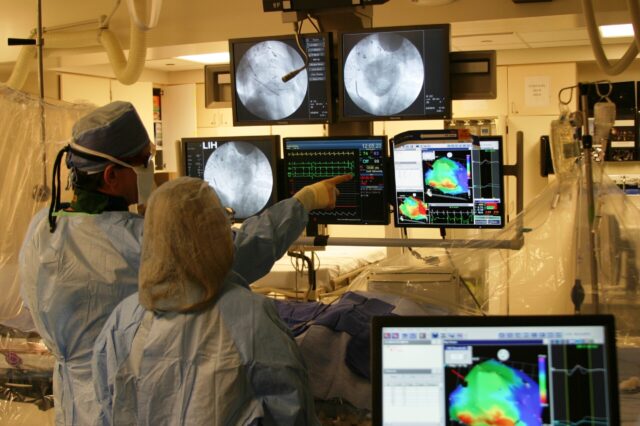Alternative Names
Myocardial infarction - thrombolytic; MI - thrombolytic; ST - elevation myocardial infarction; CAD - thrombolytic; Coronary artery disease - thrombolytic; STEMI - thrombolytic
Information
Small blood vessels called coronary arteries supply oxygen carrying blood to the heart muscle.
- A heart attack can occur if a blood clot stops the flow of blood through one of these arteries.
- Unstable angina refers to chest pain and other warning signs that a heart attack may happen soon. It is most often caused by blood clots in the arteries.
Some people may be given drugs to break up the clot if the artery is completely blocked.
- These drugs are called thrombolytics, or clot-busting drugs.
- They are only given for a type of heart attack, where certain changes are noted on the ECG. This type of heart attack is called an ST segment elevation myocardial infarction (STEMI).
- These drugs should be given as soon as possible after the chest pain first occurs (most often in less than 12 hours).
- The medicine is given through a vein (IV).
- Blood thinners taken by mouth may be prescribed later to prevent more clots from forming.
The main risk when receiving clot-busting drugs is bleeding, with the most serious being bleeding in the brain.
Thrombolytic therapy is not safe for people who have:
- Bleeding inside the head or a stroke
- Brain abnormalities, such as tumors or poorly-formed blood vessels
- Had a head injury within the past 3 months
- A history of using blood thinners or a bleeding disorder
- Had major surgery, a major injury, or internal bleeding within the past 3 to 4 weeks
- Peptic ulcer disease
- Severe high blood pressure
Other treatments to open blocked or narrowed vessels that may be done in place of or after treatment with thrombolytic therapy include:
References
Amsterdam EA, Wenger NK, Brindis RG, et al. 2014 AHA/ACC guideline for the management of patients with non-ST-elevation acute coronary syndromes: a report of the American College of Cardiology/American Heart Association Task Force on practice guidelines. J Am Coll Cardiol. 2014;64(24):e139-e228. PMID: 25260718 pubmed.ncbi.nlm.nih.gov/25260718/.
Bohula EA, Morrow DA. ST-elevation myocardial infarction: management. In: Zipes DP, Libby P, Bonow RO, Mann DL, Tomaselli GF, Braunwald E, eds. Braunwald's Heart Disease: A Textbook of Cardiovascular Medicine. 11th ed. Philadelphia, PA: Elsevier; 2019:chap 59.
Ibanez B, James S, Agewall S, et al. 2017 ESC guidelines for the management of acute myocardial infarction in patients presenting with ST-segment elevation: The Task Force for the management of acute myocardial infarction in patients presenting with ST-segment elevation of the European Society of Cardiology (ESC). Eur Heart J. 2018;39(2):119-177. PMID: 28886621 pubmed.ncbi.nlm.nih.gov/28886621/.

